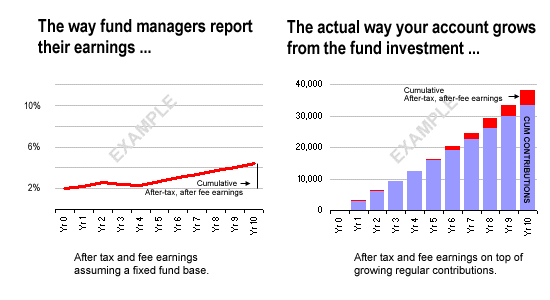
In November last year, we launched a new way of assessing KiwiSaver returns.
It differs from the official way which is to report on a fund of $10,000 and work out the after-tax, after fee returns over a stated period.
But we believe that misses a crucial component of KiwiSaver - it is a regular savings scheme where members add payroll contributions monthly over time.
Most KiwiSavers are adding to their funds on a regular way every pay period, and these monies are collected through the tax system and paid to the funds by the IRD every month.
And as the years roll by, most people get increases to their pay, which also raises the contributions they, and their employers pay.
In this way, your KiwiSaver grows incrementally every month, building from both your contributions, your employer (and government) contributions, plus (hopefully) growth in the fund unit values.
Therefore your investment is a growing contribution and the importance of the dollar returns - rather than the % returns - is amplified as that nest-egg builds.
The 'real' return to you is a balance-weighted return, favouring earnings in the periods when your fund balance is the largest.
'Real' returns are after all fees and taxes.
We set out how we do this in our earlier article.
The differences in approach can be seen best graphically:

Today, we are updating and extending our coverage.
On our KiwiSaver database we will continue to report both methods. But our unique method much more accurately reflects how most KiwiSavers save, and by focusing on $ returns, rather than % returns it is much easier for you to get a sense of the value your fund manager is adding.
Here is the update to March of the five default funds using the new perspective:
| Default Funds | Cumulative $ | + Cum net gains | Effective* | = Ending value | Effective |
| since April 2008 | contributions | after all tax, fees | cum return | in your account | last 3 yr |
| to March 2014 | (EE, ER, Govt) | $ | % p.a. | $ | return % pa |
| AMP** | 17,885 | 3,166 | 5.02 | 21,051 | 4.88 |
| ANZ Investments | 17,885 | 3,424 | 5.39 | 21,309 | 5.15 |
| ASB | 17,885 | 3,491 | 5.49 | 21,376 | 5.25 |
| Mercer (r) | 17,885 | 3,647 | 5.70 | 21,532 | 5.14 |
| Fisher Funds TWO | 17,885 | 3,261 | 5.16 | 21,146 | 5.01 |
(* This is the equivalent cumulative annual average return to achieve the after-tax and after-fees gain between the total contributions to the account and the current value of the fund for our benchmark KiwiSaver.)
(** Note for the members of the old AXA default fund. Your account has now been transferred into AMP, but the numbers above don't actually apply to you; they are just for the original AMP default fund members.)
Obviously, we do not know your personal income and earnings, so the results above aren't your's.
We have modeled a benchmark KiwiSaver individual like this:
- a full-time worker,
- on a median income,
- who was about the 500,000th signup to KiwiSaver (that is, at the end of March 2008),
- who was aged 28 on March 31, 2008,
- who has contributed 2%/2% until March 2012, and then 3%/3% (less ESCT) since,
Full details of our method is here.
(Please note that our new analysis can only be done for funds that supply unit prices. A small handful however won't supply them.)
Back to our Default funds. We now have a six year period of regular saving and investment returns under review.
We believe long term performance is a key way to assess how a fund performs. But there is always a concern that a fund may be resting of earlier laurels, and long term results don't show recent under-performance.
To keep an eye on that aspect, we are adding an additional metric - the return over the last three years. Any shorter can encourage you to consider switching in a way that is neither healthy for your returns, nor recognising of long-term gains. Don't use your KiwiSaver account as a sharetrader would. It is a long-term commitment. (If you are keen to chase high returns, choose an aggressive fund and leave the research and trading to their experts.)
Adding the extra perspective gives this revised table:
| Default Funds | Cumulative $ | + Cum net gains | Effective* | = Ending value | Effective |
| since April 2008 | contributions | after all tax, fees | cum return | in your account | last 3 yr |
| to March 2014 | (EE, ER, Govt) | $ | % p.a. | $ | return % pa |
| AMP** | 17,885 | 3,166 | 5.02 | 21,051 | 4.88 |
| ANZ Investments | 17,885 | 3,424 | 5.39 | 21,309 | 5.15 |
| ASB | 17,885 | 3,491 | 5.49 | 21,376 | 5.25 |
| Mercer (r) | 17,885 | 3,647 | 5.70 | 21,532 | 5.14 |
| Fisher Funds TWO | 17,885 | 3,261 | 5.16 | 21,146 | 5.01 |
For most default funds, the last three year returns are lower than the lifetime returns. This is because from 2008 to 2012 conservative investments did well on rising bond gains during the GFC. But from 2012 many of these gains have been rolled back as the global economies have improved. The really big gains have been in equities.
KiwiSaver default funds are only part a broader range of Conservative funds available, some of which have better returns. Here is the full list:
| Conservative Funds | Cumulative $ | + Cum net gains | Effective* | = Ending value | Effective |
| since April 2008 | contributions | after all tax, fees | cum return | in your account | last 3 yr |
| to March 2014 | (EE, ER, Govt) | $ | % p.a. | $ | return % pa |
| Milford Conservative | 4,024 | 314 | 9.11 | 4,338 | n.a. |
| BNZ Conservative | 3,113 | 144 | 6.98 | 3,257 | n.a. |
| Mercer Conservative [D] (r) | 17,885 | 3,647 | 5.70 | 21,532 | 5.14 |
| ASB Conservative [D] | 17,885 | 3,491 | 5.49 | 21,376 | 5.25 |
| ANZ OnePath Conservative [D] | 17,885 | 3,424 | 5.39 | 21,309 | 5.15 |
| Fisher Funds TWO Cash Enhanced [D] | 17,885 | 3,261 | 5.16 | 21,146 | 5.01 |
| Fidelity AC Conservative | 3,477 | 131 | 5.11 | 3,608 | n.a. |
| AMP Default [D] | 17,885 | 3,166 | 5.02 | 21,051 | 4.88 |
| BNZ Cash | 3,113 | 102 | 4.97 | 3,215 | n.a. |
| Mercer SuperTrust Fixed Interest (r) | 17,885 | 3,079 | 4.90 | 20,964 | 3.59 |
| Fidelity Capital Guaranteed | 17,885 | 2,646 | 4.27 | 20,531 | 4.01 |
| ANZ OneAnswer NZ Fixed Interest | 17,885 | 2,549 | 4.12 | 20,434 | 3.21 |
| ANZ OneAnswer Int'l Fixed Interest | 17,885 | 2,526 | 4.09 | 20,411 | 3.90 |
| Lifestages Capital Stable | 17,885 | 2,212 | 3.62 | 20,097 | 3.40 |
| AMP Cash | 17,885 | 2,145 | 3.51 | 20,030 | 3.10 |
| Aon Tyndall NZ Cash | 17,885 | 1,932 | 3.19 | 19,817 | 2.95 |
| FirstChoice NZ Cash | 17,885 | 1,895 | 3.13 | 19,780 | 3.05 |
| ASB NZ Cash | 17,885 | 1,860 | 3.07 | 19,745 | 2.96 |
| Grosvenor Enhanced Income | 17,885 | 1,773 | 2.94 | 19,658 | 2.39 |
| Brook Professional Conservative | 17,885 | 1,761 | 2.92 | 19,646 | 3.82 |
| Mercer Cash (r) | 17,885 | 1,736 | 2.88 | 19,620 | 2.07 |
| Craigs Fixed Interest | 12,952 | 908 | 2.84 | 13,860 | 2.10 |
| Fisher Funds TWO Preservation | 17,885 | 1,667 | 2.77 | 19,552 | 2.32 |
| Mercer SuperTrust Cash (r) | 17,885 | 1,643 | 2.73 | 19,528 | 1.89 |
| ANZ Cash | 17,885 | 1,552 | 2.59 | 19,437 | 2.78 |
| ANZ OnePath Cash | 17,885 | 1,546 | 2.58 | 19,431 | 2.22 |
| Staples Rodway Conservative | 17,885 | 1,489 | 2.49 | 19,374 | 2.15 |
| Westpac Cash | 17,885 | 1,469 | 2.46 | 19,354 | 2.05 |
| ANZ OneAnswer Cash | 17,885 | 1,398 | 2.35 | 19,283 | 2.07 |
| Aon ANZ OnePath Cash | 17,885 | 1,335 | 2.24 | 19,220 | 2.09 |
| [D] = Default fund | |||||
| This list includes funds which started later than March 31, 2008 which is why cumulative contributions can be less than $17,885. The list is sorted by effective cumulative return since 2008. | |||||
In addition, savers interested in risk-protected returns should consider Westpac's capital 'guaranteed' funds.
These funds invest in equities but have a Capital Protection Plan is designed to give you the opportunity to earn the higher returns normally associated with growth assets without the risk of losing your initial contributed capital (other than through the insolvency of the Capital Protection Provider or a "tax change event"). The goal of generating higher returns is implemented by having as much of the CPP Fund as possible invested in growth assets.
However, the Manager is also required to preserve the capital value of the Fund. It does this by reducing the amount invested in growth assets if the value of the assets of the CPP Fund falls below certain predetermined levels. Instead, some (or, if there is a very dramatic fall in the value of the growth assets, all) of the assets of the CPP Fund are placed in a form of deposit with the Capital Protection Provider that is designed to recover part of the value of the assets over time but does not produce a positive investment return (these are sometimes called zero coupon bonds or deposits).
Westpac has five such plans, all starting at different times:
| Capital protected | Cumulative $ | + Cum net gains | Effective* | = Ending value | Effective |
| since April 2008 | contributions | after all tax, fees | cum return | in your account | last 3 yr |
| to March 2014 | (EE, ER, Govt) | $ | % p.a. | $ | return % pa |
| Westpac CP Plan No. 1 | 15,867 | 5,101 | 9.48 | 20,968 | 8.84 |
| Westpac CP Plan No. 2 | 12,781 | 3,484 | 10.03 | 16,265 | 9.20 |
| Westpac CP Plan No. 3 | 9,853 | 2,269 | 12.05 | 21,376 | 9.86 |
| Westpac CP Plan No. 4 | 6,708 | 1,275 | 15.40 | 20,685 | n.a. |
| Westpac CP Plan No. 5 | 3,659 | 277 | 3.10 | 21,146 | n.a. |
Don't jump into these types of funds unless you understand fully how they work in good times, and bad.
Our next review will be of 'moderate' funds.

We welcome your comments below. If you are not already registered, please register to comment.
Remember we welcome robust, respectful and insightful debate. We don't welcome abusive or defamatory comments and will de-register those repeatedly making such comments. Our current comment policy is here.